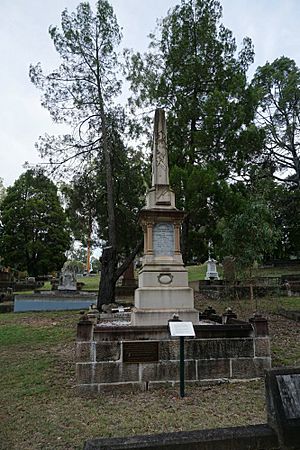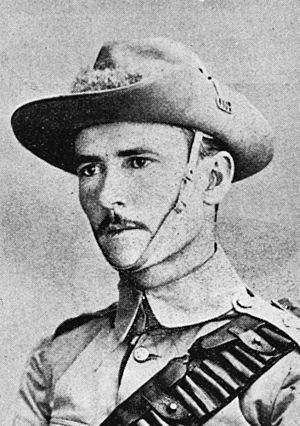Caskey Monument facts for kids
Quick facts for kids Caskey Monument |
|
|---|---|
 |
|
| Location | Toowong Cemetery, 124 Birdwood Terrace, Toowong, City of Brisbane, Queensland, Australia |
| Design period | 1900 - 1914 (early 20th century) |
| Built | 1902 |
| Architect | William Busby |
| Official name: Caskey Monument | |
| Type | state heritage (built) |
| Designated | 21 October 1992 |
| Reference no. | 600335 |
| Significant period | 1902 (fabric, historical) |
| Significant components | memorial - obelisk |
| Builders | William Busby |
| Lua error in Module:Location_map at line 420: attempt to index field 'wikibase' (a nil value). | |
The Caskey Monument is a special memorial located in Toowong Cemetery in Brisbane, Queensland, Australia. It was designed and built by William Busby in 1902. This monument is listed on the Queensland Heritage Register, which means it's an important historical site that needs to be protected.
Contents
Remembering a Hero: The Caskey Monument
This monument was put up in May 1902 to remember Lieutenant Lachlan John Caskey. He was a soldier who sadly died in a battle in South Africa on September 27, 1901. He was 31 years old when he passed away.
Lachlan Caskey was part of the 5th Queensland Imperial Bushmen. This was a group of Australian soldiers who volunteered to fight in the South African War (also known as the Boer War) from 1899 to 1902. Australian troops like Caskey fought under British command during this war.
How the Monument Came to Be
The Caskey Monument is believed to be the very first memorial in Queensland built to honour someone from the South African War. A public group was formed to collect money for it. The Queensland Government also helped pay for the monument.
A competition was held to find the best design, and a famous stonemason named William Busby won. Lachlan Caskey was a teacher and loved sports. Because of this, the monument was officially revealed by the Minister of Public Instruction, who was in charge of schools at the time.
Other War Memorials in Brisbane
The Caskey Monument is one of only four known memorials in Brisbane that remember the South African War. The others are the Berry and MacFarlane Monument (1902) in Sherwood, the Anning Monument (1903) in Hemmant, and the South African War Memorial (1919) in Anzac Square.
The design of the Caskey Monument, especially its tall, pointed shape (called an obelisk) and the carved cloth (shroud), seems to have inspired the look of the other memorials. There was another monument to Caskey near Allora, where he used to teach, but it is now lost.
What the Caskey Monument Looks Like
The monument is made from white sandstone found in Helidon. It stands about 5 metres (16 feet) tall. It has two main parts: a tall, pointed obelisk on top of a base, called a pedestal.
Special Carvings and Details
The white sandstone obelisk looks like it has a cloth, or shroud, draped over it. On the front of the obelisk, there's a sword carved into the stone. Below the sword, there's a quill, which is an old-fashioned pen. This quill is a way to show that Caskey was good at his studies and was a teacher.
On the sides of the monument, you can see more carvings that show Caskey's interests. On one side, there are crossed tennis racquets, and on the other, crossed cricket bats. These carvings show that he loved sports. This sports theme continues on the front of the pedestal, where a football is carved.
The pedestal also has smooth, dark Italian marble panels on all its sides. These panels are framed by columns made of brown sandstone. The front marble panel has a special message written in lead letters. A sandstone wall surrounds the entire monument.
Why the Monument is Important
The Caskey Monument is listed on the Queensland Heritage Register because it's a very important part of Queensland's history. It was one of the first memorials in the state to honour someone who fought in the South African War. It also helped set the style for other war monuments built later.
The monument gives us a special look into the past. Its design shows us what people thought was important and fashionable back in the early 1900s. It's a unique historical record and a beautiful example of art from that time.


